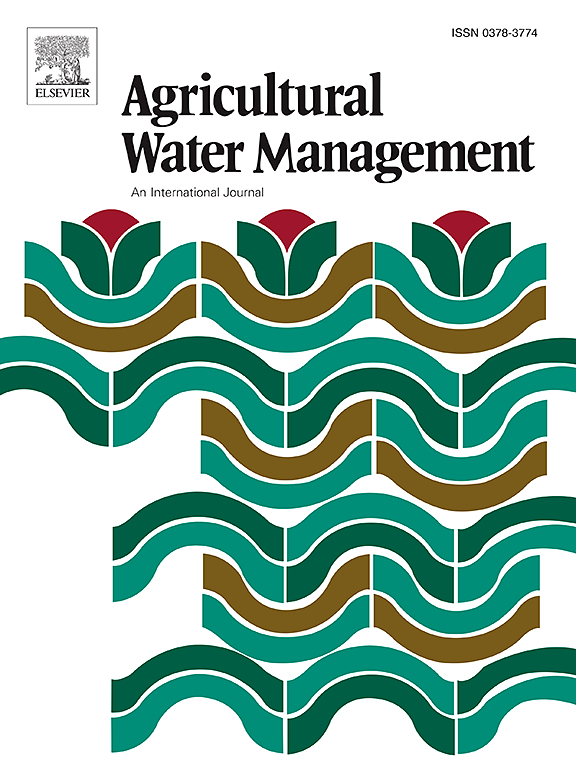铵钾对胡萝卜水分亏缺响应的影响
IF 6.5
1区 农林科学
Q1 AGRONOMY
引用次数: 0
摘要
为了全面了解胡萝卜的耐旱性,研究胡萝卜在不同干旱强度和营养补充条件下的营养稳态和理化变化是必要的。研究了土壤硝铵和叶面腐植酸钾不同施用组合和施用量对土壤养分浓度、农艺性状和灌溉水分利用效率的影响。在埃及南部地区,采用了三种亏缺水位,即充分灌溉水位、持续轻度亏缺水位和中度亏缺水位。目前的工作是在三个重复的分裂图中组织的。采用轻度亏缺水平,施用250 kg ha−1硝酸铵配施200 g 100 L−1腐植酸钾,可以缓解胡萝卜植株的胁迫,提高灌溉水分利用效率。采用此方法在短期轻微赤字期内增加叶片K(+ 29 %),浓度毫克(+ 45 %),钠(+ 24 %)和锌(+ 12 %)和减少叶片N浓度(-10 %),P (-13) %, Fe(-18 %),Mn(-21 %)和铜(-25 %)相比,富水条件,而在这漫长柔和的赤字,叶子P浓度(+ 25 %),K(+ 44 %),Ca(+ 11 %),Mg(+ 21 %),钠(+ 8 %),和铜(+ 7 %)的浓度增加,叶片N(8 %)、铁(-12 %),Mn(-30 %)较丰水灌溉降低。营养平衡的适应性反应提高了胡萝卜对亏缺胁迫的适应能力,使植物能够维持其发育过程和水分利用。有趣的是,当腐植酸钾用量增加到400 g 100 L−1,并在水分充足的条件下与250 kg N ha−1联合施用时,对胡萝卜的水分利用产生了负面影响,与轻度和中度亏缺相比,分别减少了52 %和33 %。本文章由计算机程序翻译,如有差异,请以英文原文为准。
Ammonium and potassium effects on carrot response to water deficit
For a comprehensive understanding of carrot drought tolerance, studying nutrient homeostasis alongside physiochemical modifications, especially under different drought intensities and nutrient supplements is essential. In this work, the effect of soil ammonium nitrate and foliar potassium humate applications in different combinations and rates on nutrient concentrations, agronomic traits, and irrigation water use efficiency was investigated. Three deficit water levels in the field in southern of Egypt were used, namely well-watered irrigation level, continuous mild deficit level, and moderate deficit level. The current work was organized in a split-plot with three replicates. Adopting the mild deficit level and applying 250 kg ha−1 ammonium nitrate combined with 200 g 100 L−1 potassium humate yielded beneficial impacts that relieved carrot plants stress and lead to enhanced irrigation water use efficiency. Adopting this approach in the short mild deficit term increased leaf concentrations of K (+29 %), Mg (+45 %), Na (+24 %), and Zn (+12 %) and decreased leaf concentrations of N (-10 %), P (-13)%, Fe (-18 %), Mn (-21 %), and Cu (-25 %) compared to well-watered conditions, while in the long mild deficit term, the leaf concentrations of P (+25 %), K (+44 %), Ca (+11 %), Mg (+21 %), Na (+8 %), and Cu (+7 %) increased and leaf concentrations of N (-8 %), Fe (-12 %), and Mn (-30 %) decreased compared to well-watered irrigation. The adaptive responses in nutrient homeostasis improve carrot resilience to deficit stress and allow plants to maintain their developing processes and water use. Interestingly, when the potassium humate rate was increased up to 400 g 100 L−1 and applied in a combination with 250 kg N ha−1 under the well-watered level, negative impacts were observed on water use of carrots which decreased by 52 % and 33 % compared to mild and moderate deficit, respectively.
求助全文
通过发布文献求助,成功后即可免费获取论文全文。
去求助
来源期刊

Agricultural Water Management
农林科学-农艺学
CiteScore
12.10
自引率
14.90%
发文量
648
审稿时长
4.9 months
期刊介绍:
Agricultural Water Management publishes papers of international significance relating to the science, economics, and policy of agricultural water management. In all cases, manuscripts must address implications and provide insight regarding agricultural water management.
 求助内容:
求助内容: 应助结果提醒方式:
应助结果提醒方式:


